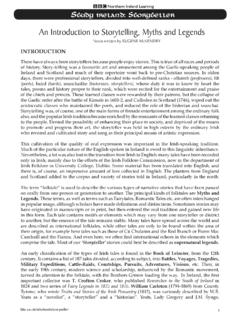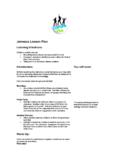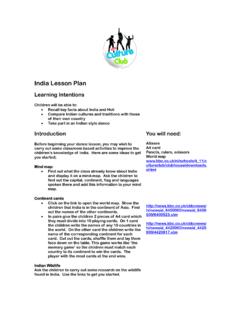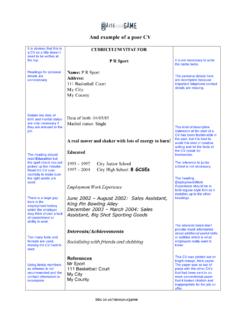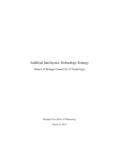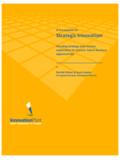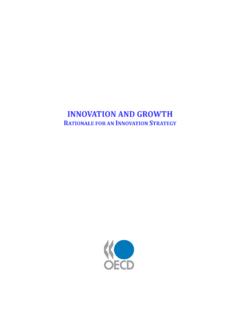Transcription of BBC Technology Strategy
1 Copyright 2010 BBC All Rights Reserved BBC Technology Strategy Issued: January 2010 For more information contact: Copyright 2010 BBC All Rights Reserved 1 Technology Strategy Introduction This paper defines the BBC s Technology Strategy in terms of key principles and a framework for the development of detailed strategies for each Technology area. The Strategy takes a long-term view of the Technology direction for the BBC. However, due to the complexity and breadth of factors affecting Technology and the business, the Strategy has a rolling two year detailed outlook. The currently ongoing and subsequent step to this paper is the development of the detailed Technology strategies which are being written to reflect the direction set out in this paper. As an when these strategies are completed they will be made available. 2 Context Technology is central to much of what the BBC does and this is becoming increasingly so right across the BBC.
2 Key drivers for this include the pace of Technology change, competitive forces, greater demands on the business and audience behaviour changes. Additionally the media industry is going through significant transition towards greater integration of Technology and content, both in the linear broadcast world as well as in the online and interactive media space. Greater interconnection between all of the BBC s systems as well as with the systems of our suppliers and partners means that Technology delivery is becoming more complex and challenging. The move towards digital content and file based media is leading to significant demand on the BBC s IP based networks, data centres, storage and metadata systems. All of this creates security, monitoring, resilience and service engineering demands well beyond where the BBC is today. In the same way that content and Technology are moving closer together, blurring once clear demarcation, the line between online and broadcast technologies is no longer clear.
3 Greater choice: Audiences are spending more of their time getting their information, entertainment and education from interactive and on demand services online through mobile, PC and set top box. Our audiences are now spending a rising proportion of their media consumption time with international players such as Hulu, Google, Microsoft and Facebook. In the television arena HD, 3D and interactive television are introducing challenges from commissioning right through to distribution. The share of online live streaming and on demand content consumption for both television and radio is growing, in some cases up to 15% of all viewing of specific shows now being on demand. Interactive experience. The Internet is democratising content distribution. Today s users expect not just to passively view content on linear channels, but to choose when they want to consume it, comment on it and share it with friends. Technology is required to do much more than simply distribute content over one broadcast network.
4 The barrier of entry for mass distribution of media is coming down quickly. The Internet is providing an easy and inexpensive way for new and existing media providers to reach audiences of tens and even hundreds of millions of people for relatively modest investment. Caching and cloud services are bringing the ability to serve millions online users into the reach of small companies and even individuals while services such as YouTube are making distribution of media, including HD content, simple and free. The BBC will need to be able to react to increasing levels of consumer expectation. Rapid pace of change. Competitors are able to reach mass audiences more quickly than ever before. For example, the number of Facebook registered users increased exponentially in 2009, from 100 million in Copyright 2010 BBC All Rights Reserved 2 January to 250 million in July. The BBC can thus no longer think of Technology in time-periods of decades, but of years; the amount of new technical information is doubling every two years.
5 Strategies should allow agility in responding to these ever-changing audience demands. Years to reach an audience of 50 million people Diagram which shows radio took approximately years for Radio to reach 50 million subscribers and facebook only approximately Technology is intrinsic to content delivery. Technology now plays an increasingly important role for the creative industry, in both the production and distribution of content. Technology can not be regarded as a commodity element. As competition for audiences intensifies, in many cases the production of excellent content must be developed in conjunction with the appropriate Technology . Technology enables competitors to be adaptable, efficient and effective. There is a greater dependence on Technology to provide the tools to build and distribute the content and services that keeps the BBC relevant to audiences. The BBC has always been a media Technology corporation and should continue to be one.
6 Convergence is driving behaviour. Technology convergence has been evident for some time with commodity IT being utilised for solutions which were historically delivered by broadcast specialist systems such as video editing and distribution. However, convergence is also occurring across enterprise Technology and online. Audience expectations of interactive and on-demand services like BBC iPlayer are the same as for linear broadcast. This means that the reliability, robustness and scalability historically associated with linear are increasingly important for interactive and on demand. While on the broadcast engineering side the demands generated by Technology change, audience expectation and competitive pressures mean that these systems need to be increasingly agile and flexible, able to adapt quickly to new demands. Continuous Improvement Over the last 6 years the BBC has embarked on an aggressive program of outsourcing Technology .
7 It is essential that the BBC continues to develop a robust and objective policy around outsourcing and the management of outsourced Technology and service delivery. This is inextricably linked to the BBC s Technology Strategy as it forms a major part of the delivery of that Strategy . In addition to focussing on audience facing Technology and services the BBC needs to ensure it meets the evolving demands in our back office and business systems in order to provide the business with the ability to deliver on our goals. Copyright 2010 BBC All Rights Reserved 33 Aims of the Technology Strategy The BBC has emerged from a Technology plateau which meant that we could take advantage of commoditising and outsourcing Technology to enable funds and resources to be re-directed to on air propositions. The outsourcing and commoditisation of Technology in recent years has resulted in a reduced onus on Technology to inform and shape the corporation direction.
8 The Technology operating model was built around these principles and still exists today. The rapid pace of Technology change in the market and steep upward curve on Technology dependency means that the BBC needs to change gear in terms of its relationship with Technology and how it fulfils some of the BBC s public purposes such as sustaining civil society and helping to deliver the benefits of emerging communications technologies and services. In response to the needs of the BBC divisions the Technology Strategy aims to enable the BBC to become a more agile, responsive and dynamic organisation. The Strategy also has to be conscious of growing financial pressures, organisational strain and maintaining if not improving quality of service. The BBC needs to be technically agile and must be responsive to internal developments and market influences to keep at the forefront of its primary function to inform, educate and entertain.
9 To achieve this, the core ambitions at the heart of the Technology Strategy are: Focus on the core building blocks The BBC needs to focus more on core infrastructure and business sytems. There is a growing dependence on business systems such as commissioning, scheduling, production systems to play an increasingly important role in the efficient development and integration of new audience facing services as well as performing their primary function. Frictionless - Technology used in the BBC should be fit for purpose and just work. Technology should make tasks simpler, faster or better. This includes focus on accessibility and flexible working to allow employees outside BBC buildings to interact with systems and services as if sitting in the office, but should be baked into all aspects of Technology . In all Technology innovation, the BBC should be looking to create flexible and adaptable solutions that will enable future demands.
10 An example of this would be to use services based architectures that allow connection from yet undefined systems. Connected and Collaborative It is vital that the BBC focuses on and improves the collaboration and engagement model both across divisions and within them to realise financial and operational benefits. Achieving a connected BBC requires a continuing shift towards open, modular and IP based technologies to create a BBC infrastructure and core services which are needed now and in the future. External partnerships are key to the BBC. The development of Technology going forward must therefore be designed to be open and modular enough to allow benefits to be leveraged by key partners. Fostering Innovation Innovation is at the heart of what the BBC delivers and the application of Technology innovation should be encouraged and enabled in all aspects of Technology provision. Externally, consumer innovation is heavily influencing what new services the BBC provides based on trends in consumer technologies, platforms and creative and innovative ideas from new competitive organisations.

